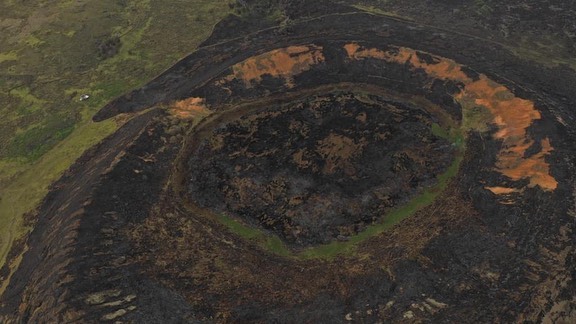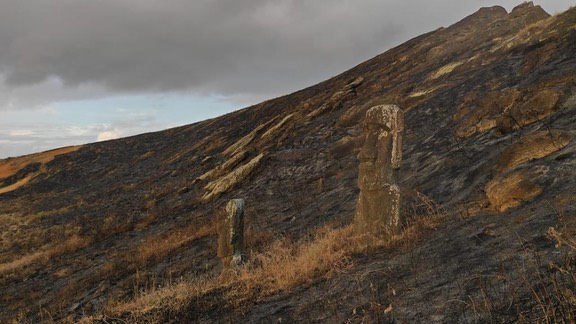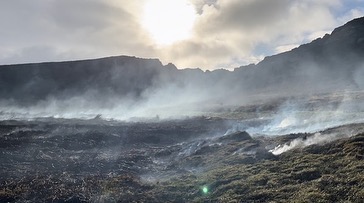Easter Island, or Rapa Nui, is a territory of Chile located in the southeastern part of the Pacific Ocean.
The forest fire that started on October 5 andaffected a significant part of the National Park, causing "irreparable damage" to some of the famous monumental heads carved from stone, according to local authorities. Some of them were completely destroyed, others were seriously damaged.
Easter Island Heads
Easter Island is the most remote inhabited island inthe world. This is the territory of Chile, located about 3.5 thousand km from the coast of South America. About a thousand statues with an average height of 4 m are placed throughout the island. It is believed that all these statues were made between the 13th and 15th centuries by the indigenous inhabitants of the island - rapanui.
Although moai are full body statues,they are often referred to as the heads of Easter Island. This is due to the disproportionate size: the ratio between the head and the body is three to five. Such proportions are believed by archaeologists to be consistent with the Polynesian belief in the sacredness of the chief's head. In addition, many of them are buried in the ground up to their shoulders, and therefore only the head remains above the ground.
Moai are monolithic statues carved fromcompressed volcanic ash. Human figures were first outlined in the stone wall, and then the excess material was cut away until only the image remained.
 Statues from Easter Island. Image: CC BY-SA 3.0, Link
Statues from Easter Island. Image: CC BY-SA 3.0, Link
The peculiarity of the sculptural figures is heavy eyebrows andlong noses with a characteristic hook-shaped bend of the nostrils. The massive figures of the statues are poorly drawn, but sometimes the clavicles are outlined in stone. The arms are carved in bas-reliefs and rest on the body in various positions. As a rule, the backs of giants are devoid of details, but sometimes rings and belts are depicted on the buttocks and lower back. With the exception of one kneeling moai, the statues do not have decorated legs.
 Kneeling statue. Image: Pavel Špindler, CC BY 3.0, via Wikimedia Commons
Kneeling statue. Image: Pavel Špindler, CC BY 3.0, via Wikimedia Commons
About half of the sculptures are still inquarry Rano Raraku - a volcanic crater containing the ashes of ancient eruptions. But hundreds of statues were moved from there and installed on stone platforms around the entire perimeter of the island.
The reasons for the creation of carvings, which, asbelieved to depict the ancestors of the Rapanui people are unknown. One of the studies drew attention to the fact that stone idols were installed next to freshwater sources.
What happened?




Consequences of the fire. Photo: Municipalidad de Rapa Nui
The forest fire that started on October 5thspread over most of the island. According to the mayor of the island, Pedro Edmunds Paoa, the area affected by the incident is at least 100 hectares. At the same time, the fire occurred at "the most significant place of all: the Rano Raraku quarry", in which more than half of all the sculptures remained.
As a result of the fire, several stone headscompletely burned out. And about half of the sculptures cracked. The mayor also noted that as the stone cracks, in heavy rain or over time, it loosens, falls and becomes sand. At the same time, sculptures that were completely excavated suffered the most.
Local authorities suspect that the fire was notaccident, but is a consequence of human activity. This is not the first time damage has been caused to ancient sculptures. For example, in 2008, a Finnish tourist was fined $17,000 for breaking off a piece of the ear from one of the sculptures. He was also banned from returning to the island for three years.
And in 2020, a resident of the island was arrested forthat he damaged one of the sacred statues with a pickup truck. The man left the truck on the slope, putting a stone in place of the parking brake, but the car rolled and crashed into one of the sculptures.




Consequences of the fire. Photo: Municipalidad de Rapa Nui
What will happen next?
Local authorities note that problems with controlfor the state of the World Heritage monument is associated with a lack of funding and low participation of the state in the conservation of monuments. The main burden, he said, falls on the municipality and volunteers, who cannot provide adequate protection.
On October 12, the city hall held a meeting withUNESCO representatives requesting assistance in the restoration and protection of the monument. A statement issued following the meeting noted that the organization will take part in the restoration work.
Local authorities and representatives of an international organization will form a working group that will assess the damage and develop a plan to restore and protect the remaining sculptures.
Read more:
Created a compact nuclear reactor for safe energy production
Unusual structures found on the edge of the solar system. Only the Voyagers have been there.
Black hole 'spit out' torn star three years after swallowing